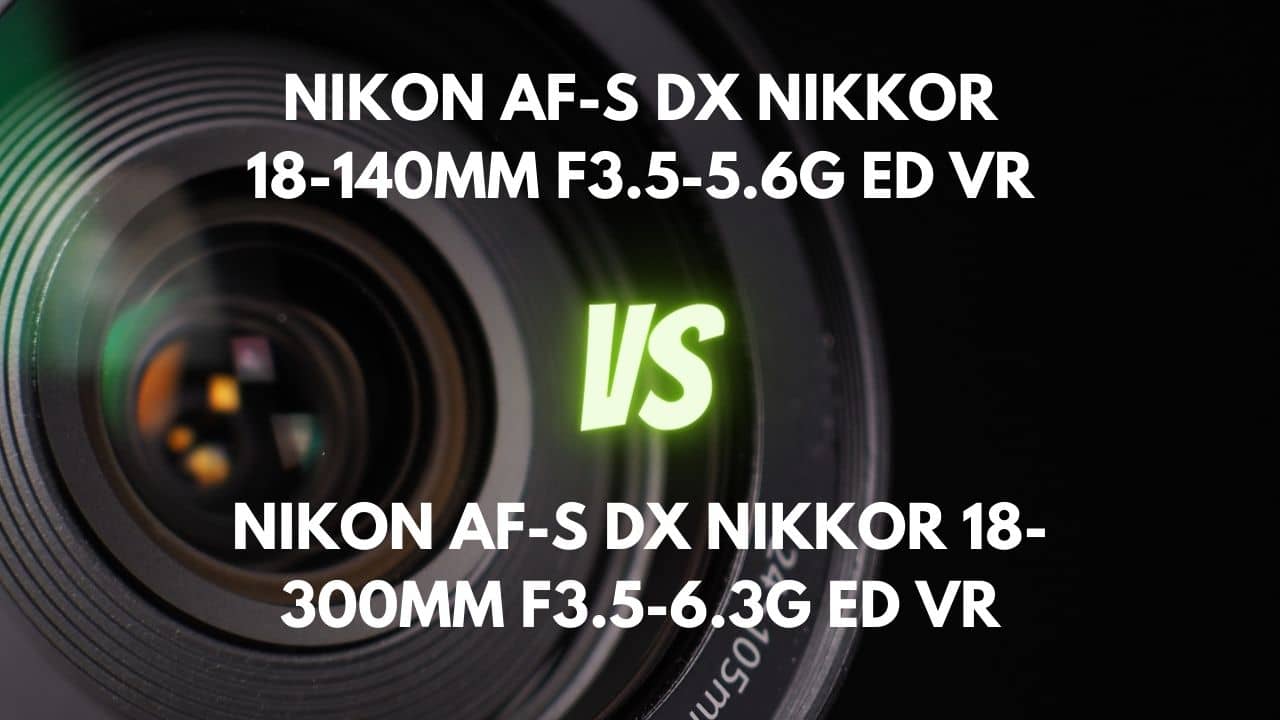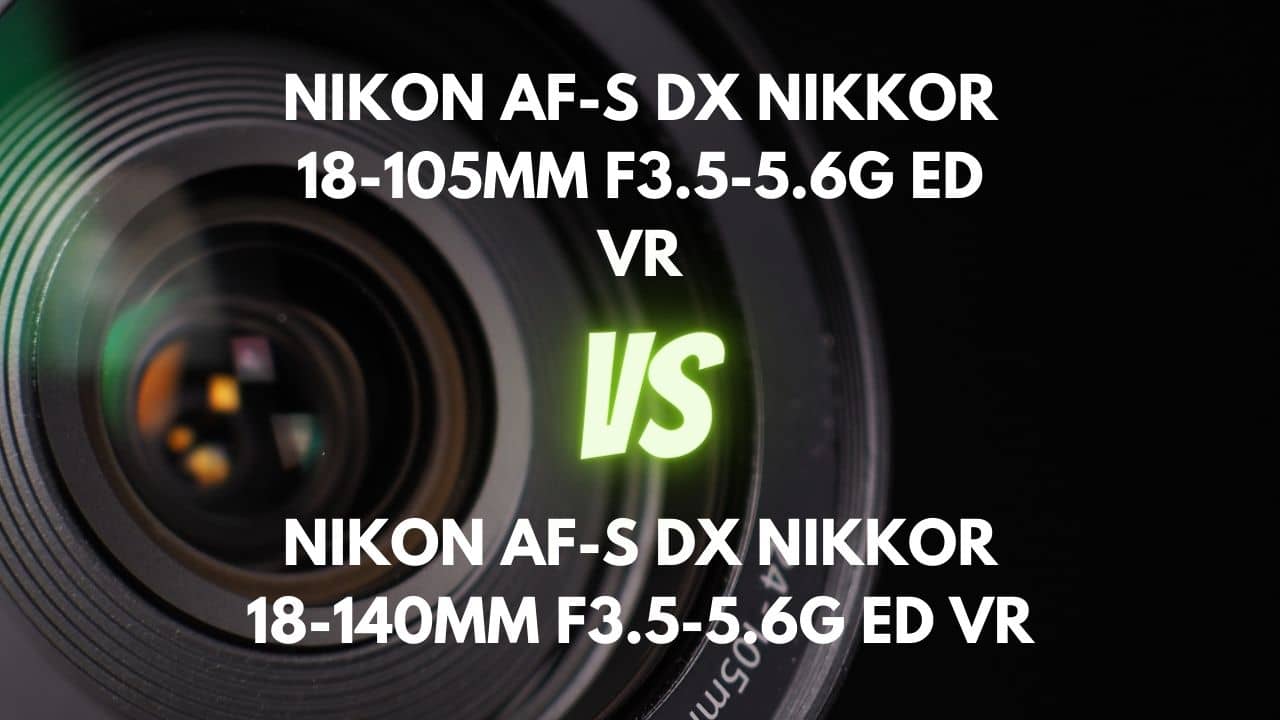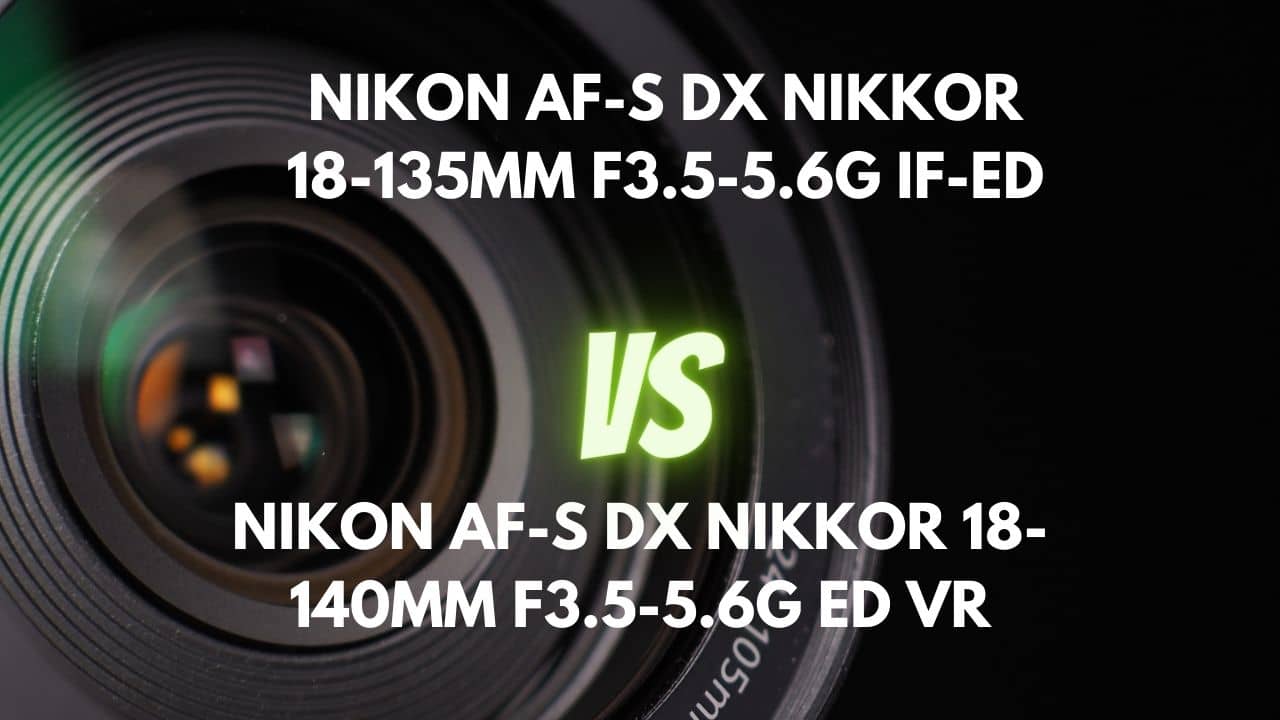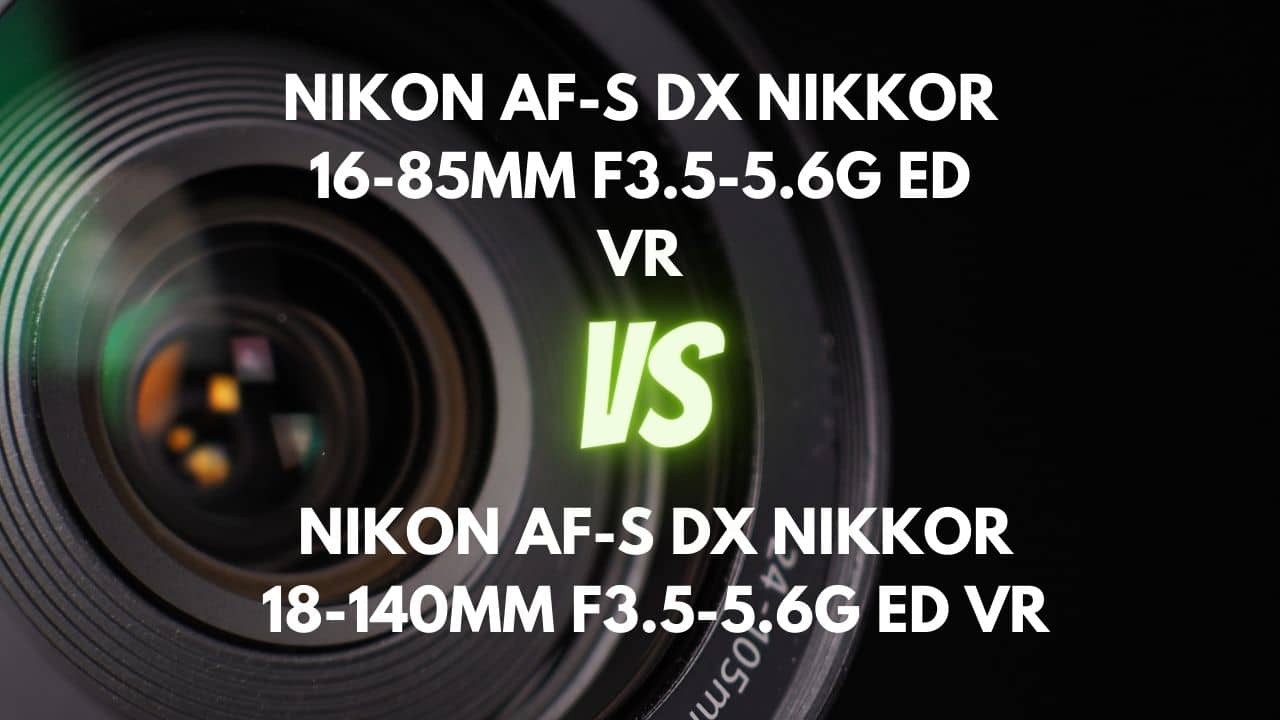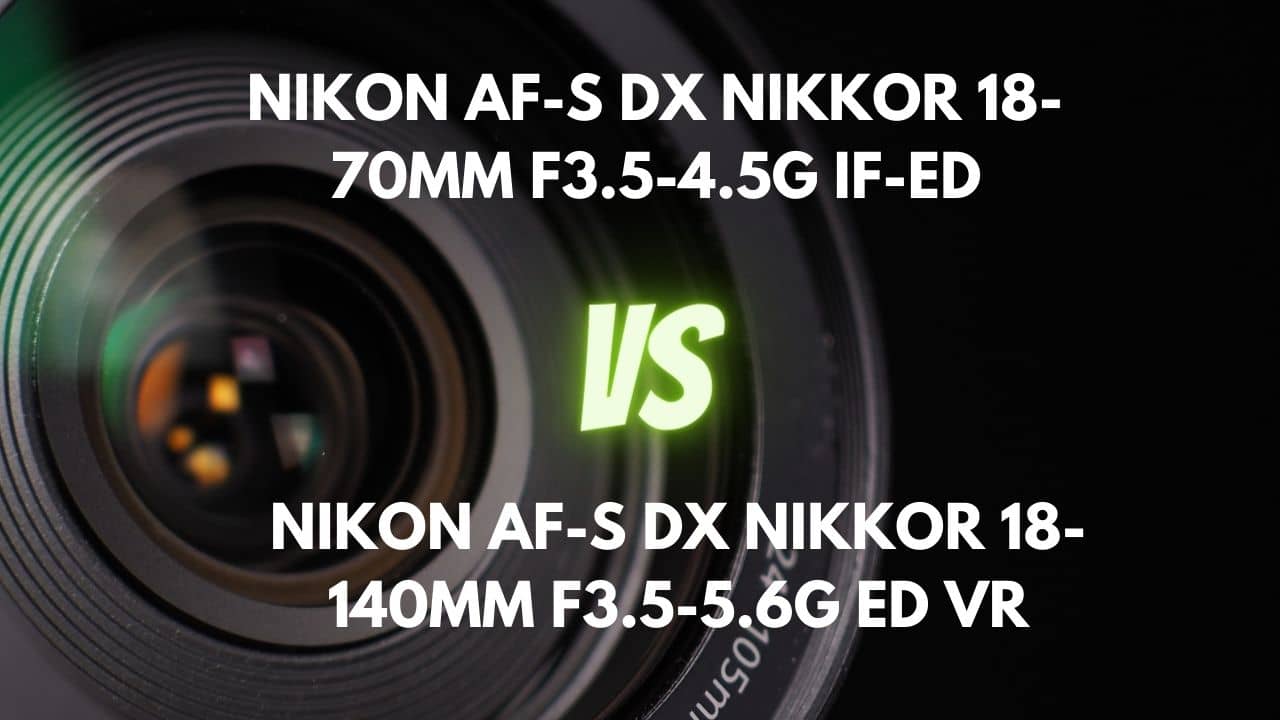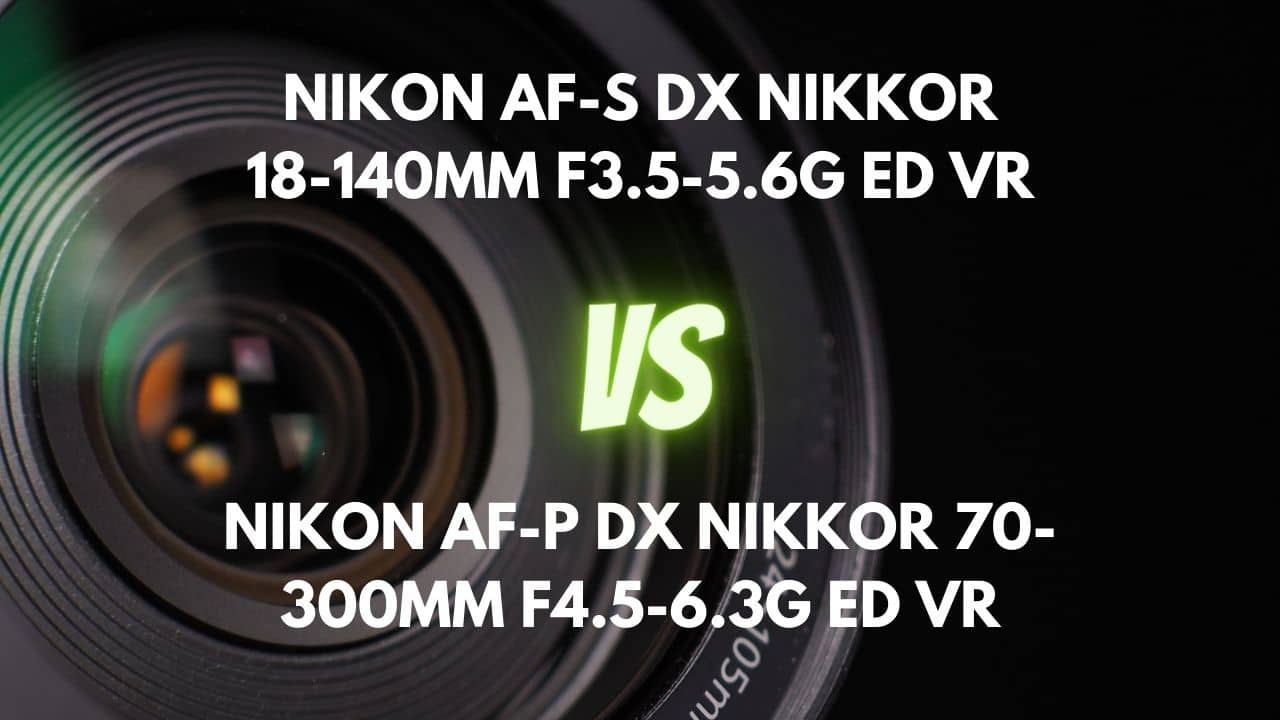Are you a passionate photographer looking to expand your gear with a versatile, all-in-one lens that can adapt to various shooting scenarios? Look no further!
In this article, we’ll be comparing two popular Nikon lenses – the Nikon DX 18-140mm f/3.5-5.6 and Nikon DX 18-200mm f/3.5-5.6 – to help you find the perfect companion for your photography adventures. Whether you’re a landscape enthusiast, a portrait aficionado, or a wildlife observer, these lenses offer unique benefits tailored to your specific needs.
From wide-angle shots to capturing distant subjects, both lenses boast a range of features that cater to photographers seeking convenience, flexibility, and top-notch performance.
As we delve into a detailed comparison of these lenses, you’ll discover their strengths and weaknesses, allowing you to make an informed decision that aligns with your photography priorities.
So, buckle up and join us on this exciting journey to find the ideal lens that can elevate your creativity and capture those unforgettable moments with unparalleled clarity and precision.
Overview
| Nikon AF-S DX NIKKOR 18-140mm F3.5-5.6G ED VR | Nikon AF-S DX NIKKOR 18-200mm F3.5-5.6G ED VR II | |
|---|---|---|
| Max Aperture | F3.5-5.6 | F3.5-5.6 |
| Aperture Type | Variable | Variable |
| Focal Range (mm) | 18-140 | 18-200 |
| Max Format | APS-C / DX | APS-C / DX |
| Zoom Ratio (X) | 7.8 | 11.1 |
The Nikon DX 18-140mm f/3.5-5.6 and Nikon DX 18-200mm f/3.5-5.6 are both versatile zoom lenses designed for APS-C / DX format cameras, with variable apertures and broad focal ranges.
Both lenses have a maximum aperture of f/3.5-5.6, which may impact their low-light performance. Both lenses have variable apertures, making them more affordable and lightweight but with some compromises in image quality and low-light performance compared to fixed aperture lenses.
The 18-140mm lens offers a 7.8x zoom ratio, covering focal lengths from wide-angle to telephoto, making it suitable for various photography genres. On the other hand, the 18-200mm lens boasts a more impressive 11.1x zoom ratio, giving it an extended telephoto reach that can be beneficial for sports, wildlife, or event photography.
In summary, both lenses offer versatility for different photography needs, but the Nikon DX 18-140mm f/3.5-5.6 is more suitable for photographers who prioritize a balance between wide-angle and telephoto capabilities. The 18-200mm lens, with its extended telephoto reach, is ideal for those who require greater flexibility in capturing distant subjects.
Design and Ease of Use
| Nikon AF-S DX NIKKOR 18-140mm F3.5-5.6G ED VR | Nikon AF-S DX NIKKOR 18-200mm F3.5-5.6G ED VR II | |
|---|---|---|
| Diameter x Length (mm) | ⌀78×97mm | ⌀77×96.5mm |
| Weight (gr) | 490 | 565 |
| Filter Thread (mm) | 67 | 72 |
| Weather Sealing | No | No |
| Zoom Method | Rotary (extending) | Rotary (extending) |
| Distance Scale | No | Yes |
| DoF Scale | No | No |
| Hood Supplied | No | Yes |
| Hood Code | HB-32 | HB-35 |
The Nikon DX 18-140mm f/3.5-5.6 has dimensions of ⌀78×97mm and weighs 490 grams, while the Nikon DX 18-200mm f/3.5-5.6 is slightly smaller at ⌀77×96.5mm but heavier at 565 grams. Both lenses use a rotary (extending) zoom method.
In terms of portability, the 18-140mm lens is lighter and easier to carry around, making it less tiring for extended periods of shooting. However, the 18-200mm lens has a more compact design, which can be advantageous in certain situations like street photography, where discreetness is important. The size and weight differences also affect the balance of your camera setup. A lighter lens, like the 18-140mm, could lead to better overall balance and handling.
Both lenses utilize the extending rotary zoom method, which is generally simpler in design and can be lighter than an internal rotary zoom lens. However, this method also means the lens extends when zooming, potentially making it more cumbersome and harder to handle. Additionally, achieving effective weather sealing can be more difficult with extending lenses, leaving them more vulnerable to dust and moisture.
In conclusion, the choice between the 18-140mm and 18-200mm lenses depends on your priorities as a photographer. The 18-140mm lens is lighter, which could provide better balance and handling, while the 18-200mm lens is slightly more compact, offering discreetness in certain situations. If you value a lighter lens for extended shooting and better balance, the 18-140mm lens may be the superior choice. However, if you prioritize a more compact design for discreetness and space-saving, the 18-200mm lens could be the better option.
Lens Mount and Barrel
The Nikon DX 18-140mm f/3.5-5.6 features a metal lens mount without any weather sealing, making it less resistant to moisture and dust compared to lenses with a sealed mount. Its lens barrel is primarily composed of polycarbonate plastic, which is lighter and more affordable than metal, although not as durable.
The lens has a textured rubber grip on the zoom ring for comfortable use and a narrower, ridged rubber grip on the manual focus ring. When zooming from 18mm to 140mm, the lens extends by just over 50 mm, with a smooth and stable inner barrel movement. As the focal length varies, the hindmost set of components shifts back and forth by approximately 3 centimeters.
On the other hand, the Nikon DX 18-200mm f/3.5-5.6 has a metal lens mount with a rubber ring for environmental sealing, protecting against dust and moisture. Its lens barrel is made of metal, providing a more premium feel and sturdiness, albeit with a heavier weight.
The lens features a well-designed ergonomic bevel and a smooth finish. When zooming, the barrel extends or retracts, but it is susceptible to zoom creep between 28 and 135mm focal lengths. To address this issue, the newer version includes a switch on the side of the barrel to lock it in the wide position during transportation.
In conclusion, the 18-140mm lens offers a lighter and more affordable option with a comfortable grip, while the 18-200mm lens provides enhanced durability, weather sealing, and a more professional feel. If you value portability and budget-friendly options, the 18-140mm lens might be the better choice. However, if you prioritize durability, weather sealing, and a more premium feel, the 18-200mm lens may be the superior option.
Weather Sealing
The Nikon DX 18-140mm f/3.5-5.6 is not weather sealed, lacking a gasket at the lens mount, internal seals at the rings, switches, or front of the barrel, and a fluorine coating on the front element. This makes the lens unsuitable for use in harsh weather conditions or environments with a high amount of moisture and dust.
On the other hand, the Nikon DX 18-200mm f/3.5-5.6 features a rubber ring on the metal mount, providing some degree of environmental sealing. However, it is not completely waterproof and also lacks internal seals at the rings, switches, and front of the barrel.
Weather sealing is an essential factor to consider for photographers who frequently shoot in challenging outdoor conditions. Lenses that are entirely weather-sealed provide superior safeguarding against dust, humidity, and minor water exposure, resulting in long-lasting durability and optimal functionality. While not a critical feature for portrait photography, weather sealing can be beneficial depending on the shooting conditions and locations.
In conclusion, the 18-200mm lens with its rubber ring on the metal mount offers a higher degree of environmental sealing compared to the 18-140mm lens. Although neither lens is fully weather sealed, the 18-200mm lens provides some protection against the elements, making it a more suitable choice for photographers who occasionally shoot in unpredictable or adverse conditions.
However, if you primarily shoot in controlled environments or indoor settings, the weather sealing difference between these two lenses may not be a crucial factor in your decision-making process.
Rings
The Nikon DX 18-140mm f/3.5-5.6 features two rings: a zoom ring and a focusing ring. The zoom ring, located near the front of the lens, has a thick, textured rubber grip band, providing comfortable handling and precise control.
The focusing ring, situated behind the zoom ring, is narrower but still sports a ridged rubber grip band. While the zoom ring offers nice resistance and is well-damped, the focusing ring’s long throw doesn’t provide much tactile feedback. This lens lacks a windowed distance scale, depth-of-field indicators, and an extension lock switch on the zoom ring.
The Nikon DX 18-200mm f/3.5-5.6 also has two rings: a zoom ring and a manual focus ring. Both are well-placed for ease of use, with the zoom ring positioned perfectly for thumb and forefinger operation, and the manual focus ring featuring a 10mm wide ridged rubber grip.
The rings feel smooth and are designed with ergonomic bevels. A zoom lock switch prevents zoom creep, although it can be inconvenient, requiring unlocking before use. This lens includes a recessed distance scale with settings for 0.5, 1, and 3 meters plus infinity.
Comparing the two lenses, the 18-200mm lens offers superior ring design in terms of ergonomics, precision, control, and additional features such as the distance scale and zoom lock switch. Although the 18-140mm lens has a comfortable grip and decent resistance, the 18-200mm lens provides smoother operation, better ergonomics, and more useful features.
Switches/Buttons
The Nikon DX 18-140mm f/3.5-5.6 has two control switches on its left side. One switch toggles between autofocus (A) and manual focus (M), while the other enables or disables vibration reduction (ON or OFF). Aperture control is managed via a mechanical lever. These switches provide essential functions for photographers to adapt quickly to various shooting situations.
The Nikon DX 18-200mm f/3.5-5.6 features three slider switches on the side of the lens barrel, located behind the focusing ring. These switches include M/A (autofocus with manual override) and M (manual focus) focusing modes, vibration reduction (VR) on and off, and Normal and Active VR settings. This design is well-considered and user-friendly, making it easy for photographers to access and adjust these controls as needed.
Comparing the two lenses, the 18-200mm lens offers a more comprehensive set of switches and buttons, allowing for greater flexibility and control in various shooting scenarios. With the additional Active VR setting and the M/A focusing mode, the 18-200mm lens provides photographers with more options to fine-tune their shooting experience.
Filter Thread
The Nikon DX 18-140mm f/3.5-5.6 has a 67mm wide metal filter thread, which accepts 67mm diameter attachments. The filter thread does not rotate during focus or zoom operation, making it convenient for using filters such as graduated neutral density filters and polarizers. Positioned immediately behind the filter ring, the front element is relatively flat, and a small marker on the outer perimeter of the filter ring helps users attach the optional bayonet-style lens hood.
On the other hand, the Nikon DX 18-200mm f/3.5-5.6 has a larger 72mm metal filter thread. Like the 18-140mm lens, the front element and filter thread do not rotate during focusing, which is also beneficial for angle-critical attachments and filters. As a result, using filters with this lens is straightforward and doesn’t require readjustment.
In comparing the two lenses, the 18-200mm lens has a slight advantage due to its larger filter thread size. This could provide users with more filter options, as well as potentially reduced vignetting and better image quality. However, larger filters might be more expensive, so budget-conscious photographers may still prefer the 67mm filter thread size of the 18-140mm lens.
Lens Hood
The Nikon DX 18-140mm f/3.5-5.6 does not include a lens hood in the package, making it an optional accessory that must be purchased separately. This petal-shaped hood is made of plastic and features a bayonet mount. It can be reversed for storage and has an ergonomic bevel for smooth rotation. The primary purpose of the hood is to prevent lens flare and protect the front element of the lens from impacts.
On the other hand, the Nikon DX 18-200mm f/3.5-5.6 includes a lens hood in the package, alongside a snap-on front lens cap, rear lens cap, and a flexible lens pouch. This hood also uses a bayonet mount and is made of plastic with a matte finish. The ergonomic bevel ensures easy attachment and removal, while the hood can be smoothly rotated to adjust its angle.
Comparing the two, the 18-200mm lens has the advantage of including the lens hood in the package, providing users with immediate access to its benefits, such as reducing lens flare and protecting the front element. Although both hoods use a bayonet mount and have an ergonomic bevel for smooth rotation, the 18-200mm lens offers a more complete package with the included lens hood.
Focusing and Optical Stabilization
| Nikon AF-S DX NIKKOR 18-140mm F3.5-5.6G ED VR | Nikon AF-S DX NIKKOR 18-200mm F3.5-5.6G ED VR II | |
|---|---|---|
| Autofocus | Yes | Yes |
| AF Motor | Silent Wave Motor | Silent Wave Motor |
| Rotating Front Element | Does not rotate on focusing | Does not rotate on focusing |
| Min Focus Distance | 0.45m | 0.5m |
| Max Magnification (X) | 0.23 | 0.22 |
| Full-Time Manual Focus | Yes | Yes |
| Focus Method | Internal | Internal |
Focusing Performance
The Nikon DX 18-140mm f/3.5-5.6 offers an ultrasonic Silent Wave Motor, ensuring autofocus operation that is reasonably fast, very quiet, and almost silent. This lens works well in both single-servo autofocus and continuous autofocus modes. It allows manual focus override by simply turning the focus ring for a smooth focusing experience.
With an internally focusing design, the lens maintains a constant length, and the front element does not rotate during focusing. Nonetheless, the lens does display focus breathing, whereby the image appears to shrink as it is focused in closer, primarily when using the lens at the longer end of its zoom range.
In contrast, the Nikon DX 18-200mm f/3.5-5.6 features a Silent Wave Motor for autofocusing, which is nearly silent and efficient. The focusing speed is generally adequate, taking around 1.2 seconds to go from infinity to 50cm and back again. In well-lit situations, autofocus performance is reliable and accurate. Performance in low-light situations may be slightly slower, but still satisfactory.
The lens also offers a full-time manual focus override that is smooth and allows for precise adjustments. Its internally focusing design ensures that the length of the lens remains constant regardless of focus and zoom settings, and the front element does not rotate during focusing. The lens does not exhibit significant focus breathing, contributing to its overall solid autofocus performance.
Comparing the two lenses, the 18-200mm lens has the edge in focusing performance. While both lenses have silent and efficient autofocus systems, the 18-200mm lens offers a slightly faster focusing speed and does not exhibit significant focus breathing. Both lenses provide smooth manual focus override, making them versatile for various photography scenarios. Overall, the 18-200mm lens delivers superior focusing performance compared to the 18-140mm lens.
Optical Stabilization
The Nikon DX 18-140mm f/3.5-5.6 features Nikon’s vibration reduction (VR) technology, which compensates for hand-held shake up to 4 f-stops for the system in the lens. With an efficient built-in VR stabilization, photographers can shoot hand-held at slow shutter speeds, such as 1/15 second with the 140mm focal length and achieve roughly half of the shots taken sharp. The stabilization slider has 2 positions: on and off.
On the other hand, the Nikon DX 18-200mm f/3.5-5.6 boasts Nikon’s second-generation VR II vibration reduction system, which claims to allow handholding at shutter speeds 3.5 stops lower than usual. The mechanism is near-silent in use, emitting only a very quiet whirring noise when operational.
The lens offers 2 VR modes – Normal and Active. At 18mm, the VR system provides an 80% chance of getting usable results at 1/6 sec, at 50mm it provides an 80% chance at 1/13 sec, and at 200mm, an 80% chance as low as 1/25 sec. Even at slower speeds, you’ll get ‘keepers’ handheld if you’re prepared to take multiple shots.
Comparing the two lenses, the 18-200mm lens has a superior optical stabilization system with its second-generation VR II technology and multiple VR modes. While both lenses offer valuable stabilization features, the 18-200mm lens allows for greater flexibility and a higher probability of achieving sharp images at slower shutter speeds. This makes it the more advantageous choice for photographers who need better optical stabilization performance in various shooting scenarios.
Image Quality
| Nikon AF-S DX NIKKOR 18-140mm F3.5-5.6G ED VR | Nikon AF-S DX NIKKOR 18-200mm F3.5-5.6G ED VR II | |
|---|---|---|
| Special Elements | 1 ED (extra-low dispersion) glass element, 1 aspherical lens element | 2x ED glass elements and 3x aspherical lens elements |
| Diaphragm Blades | 7 | 7 |
| Circular Aperture | No | Yes |
Aberration
The Nikon DX 18-140mm f/3.5-5.6 exhibits chromatic aberration, which is slightly more noticeable in this model than in previous Nikon offerings. Nonetheless, it is generally not objectionable, with the corners of test images displaying minor dark blue fringing around areas of high contrast. Coma performance is excellent in this lens, as there is no evidence of smeared blobs around bright points of light, even in the corners of the image.
In contrast, the Nikon DX 18-200mm f/3.5-5.6 displays some chromatic aberration, with red-green fringing detected at the widest focal lengths. However, it diminishes at longer focal lengths and is easy to correct. Spherical aberration is evident in this lens, as seen in the degree of focus shifting required when apertures are stopped down. This issue is likely a consequence of the extended zoom design.
While both lenses exhibit chromatic aberration, the 18-140mm lens maintains an overall better aberration performance, making it the more desirable choice for photographers who prioritize aberration control in their images.
Sharpness
At wider apertures, the Nikon DX 18-140mm f/3.5-5.6 delivers good sharpness performance, with the center sharpness being notably impressive, and the quality further improving when stopping down to f/5.6 and beyond. However, the corner sharpness can be somewhat lacking, especially when using wider angles.
If stopped down to approximately f/8, corner sharpness experiences a significant improvement. The ideal aperture for the sharpest results varies based on the focal length used, but generally, f/8 and f/11 are the most effective. However, as the aperture size decreases, the effects of diffraction begin to manifest around f/8, and this becomes a considerable challenge when using f/16 or smaller apertures.
On the other hand, the Nikon DX 18-200mm f/3.5-5.6 showcases impressive sharpness for an F-mount superzoom, particularly at short to mid zoom settings. Center sharpness is generally excellent throughout the focal range, while corner sharpness may be slightly weaker at wider apertures but improves when stopped down.
The sharpest apertures typically range from f8 to f11. At longer focal lengths, such as 135mm and f5.6, image quality can be visibly impacted, but stopping down to f11 can yield better results. This lens is capable of delivering sharp images, although not as sharp as some prime lenses or more specialized zoom lenses. Overall, the lens offers a versatile and convenient zoom range with a good balance of sharpness and image quality.
In conclusion, both lenses offer good sharpness performance, but the 18-200mm lens demonstrates a more impressive sharpness for a superzoom lens, particularly at short to mid zoom settings. While the 18-140mm lens has good sharpness as well, the 18-200mm lens provides a better balance of sharpness and image quality across a broader focal range, making it the superior choice for photographers seeking versatility and convenience without sacrificing too much sharpness.
Bokeh Quality
The Nikon DX 18-140mm f/3.5-5.6 features an iris diaphragm with 7 blades, resulting in a somewhat nervous bokeh. The quality of bokeh is subjective and varies from decent to satisfactory, depending on factors such as focusing distance, focal length, and aperture settings. To achieve the softest backgrounds, you can stand back and zoom in to the longest focal length possible, shooting at 140mm f/5.6.
On the other hand, the Nikon DX 18-200mm f/3.5-5.6 can deliver smoothly blurred out-of-focus regions, particularly at 200mm f/5.6, but the bokeh is not entirely smooth. Hard-edged specular highlights can give a harsh appearance to defocused areas. However, with careful selection of the background and thoughtful composition, it is possible to achieve appealing results. Some users have reported distracting and nervous bokeh that required additional post-processing to smooth out.
In conclusion, both lenses offer decent bokeh quality, but neither is exceptional in this aspect. The 18-200mm lens has the potential to produce smoother out-of-focus areas, particularly at its longest focal length, giving it a slight edge over the 18-140mm lens. However, achieving pleasing bokeh with either lens may require some effort and attention to composition.
Flare/Ghosting
The Nikon DX 18-140mm f/3.5-5.6 demonstrates minimal flare and ghosting in most situations, thanks to Nikon’s Integrated Coating, which helps reduce these optical anomalies. Nevertheless, when photographing directly towards the sun or other intense light sources, some ghosting may become noticeable.
Utilizing the optional petal-shaped lens hood (HB-32) can further decrease the chances of flare and ghosting. Indeed, the occurrence of ghosting can be somewhat managed, with fixed lenses typically exhibiting fewer ghosts than older, single-coated zoom lenses.
On the other hand, the Nikon DX 18-200mm f/3.5-5.6 exhibits minimal flare and ghosting, as long as it is not pointed directly into the sun. When forced to flare, it produces starbursts, rainbow effects, and circular patterns of various colors.
However, contrast is not significantly affected. The lens handles flare relatively well, especially compared to some other lenses in its class, and its complex optical construction allows for intricate flare patterns at small apertures.
In conclusion, both lenses perform well in terms of flare and ghosting control. The 18-140mm lens benefits from Nikon’s Integrated Coating, while the 18-200mm lens handles flare relatively well and can produce intricate flare patterns. Choosing the superior lens for flare and ghosting control depends on your specific needs and preferences. If you prioritize more consistent flare control, the 18-140mm lens may be the better choice. However, if you appreciate the potential for creative flare patterns and can manage occasional rainbow effects or starbursts, the 18-200mm lens could be the ideal option.
Vignetting
The Nikon DX 18-140mm f/3.5-5.6 displays apparent vignetting at different focal lengths, particularly when in-camera correction is turned off. Vignetting is more noticeable towards the ends of the zoom range than in the middle. To mitigate vignetting, stopping down the aperture to f/5.6 or f/8 can be effective in brightening up the corners.
In contrast, the Nikon DX 18-200mm f/3.5-5.6 shows occasional vignetting, particularly at wider focal lengths. However, compared to its competition, this lens has demonstrated better optical performance in terms of vignetting correction, indicating a good starting point for post-processing. It is worth noting that vignetting can be reduced effectively through software or in-camera correction, but it is always preferable for the lens to produce good results without any digital manipulation.
In conclusion, the 18-200mm lens has a superior performance in terms of vignetting compared to the 18-140mm lens. While both lenses exhibit some level of vignetting, the 18-200mm lens offers better optical performance. However, it’s essential to remember that some photographers appreciate a certain level of vignetting as an artistic touch or to draw attention to the center of the image.
Distortion
The Nikon DX 18-140mm f/3.5-5.6 exhibits noticeable distortion, especially at wider focal lengths. At 18mm, there is barrel distortion, and from 35mm to 140mm, pincushion distortion is present. Fortunately, in-camera distortion correction is available, and post-processing software can assist in correcting it. To address this issue, some users suggest enabling the Auto Distortion Correction option in the camera’s menu.
On the other hand, the Nikon DX 18-200mm f/3.5-5.6 also shows noticeable distortion, particularly at the wide-angle end, with prominent barrel distortion. This can result in a “mustache” or wavy distortion pattern that may be challenging to correct using simple software tools.
Pincushion distortion becomes more evident between 35mm and 70mm, although it is less complex and can be more easily corrected with software. It is important to note that distortion is mostly an issue in photos with straight lines, and may not be a significant problem for subjects like landscapes, portraits, or wildlife.
In conclusion, both lenses have their challenges regarding distortion, but the 18-140mm lens appears to have a slight advantage due to its less complex distortion patterns. However, depending on your photography subjects, distortion might not be a significant concern for either lens, as it is mainly an issue when capturing images with straight lines.
Final Verdict
To sum up, both the Nikon DX 18-140mm f/3.5-5.6 and Nikon DX 18-200mm f/3.5-5.6 have their strengths and weaknesses, making them suitable for different photography needs and priorities.
The 18-140mm lens is a lighter, more affordable option with better aberration performance and less complex distortion patterns, making it ideal for photographers who value balance, portability, and cost-effectiveness.
On the other hand, the 18-200mm lens offers greater telephoto reach, better focusing performance, superior optical stabilization, smoother bokeh potential, better vignetting control, and enhanced durability with some degree of environmental sealing. This lens is more suitable for photographers who require flexibility, versatility, and better performance across various shooting scenarios.

